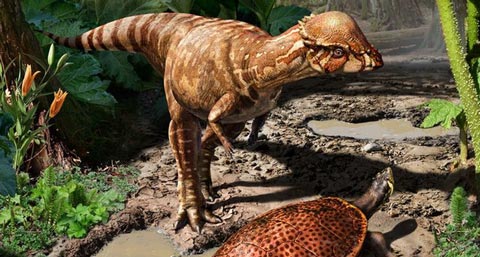New Species of Bone-headed Dinosaur Announced
The First of the Bone-heads
A team of North American scientists have announced the discovery of a new species of pachycephalosaur. Pachycephalosaurs are bird-hipped members of the Dinosauria commonly referred to as the bone-headed dinosaurs. Pachycephalosaurids are known from Upper Cretaceous fossil bearing sediments of the northern latitudes, most notably from North America.
Much of our knowledge about this group comes from a few well-preserved skeletons ascribed to the genus Stegoceras. Other species have been identified based on the fossilised remains of their thickened skulls. Indeed, so thick are the skull bones (frontal and parietal), that often these are the only fossils ascribed to a particular genera, the rest of the skeleton material presumably having been lost to erosion or failing to be preserved.
Bone-headed Dinosaur
This new species, named Acrotholus audeti may be one of the oldest types of pachycephalosaur discovered to date, certainly a candidate for the oldest pachycephalosaur known from North America. The genus name means “high dome” a reference to the thickened skull, whilst the specific name honours Roy Audet, on whose land the best-preserved specimen of skull material was found back in 2008. The scientists from the Royal Ontario Museum/University of Toronto along with co-researcher Dr Michael Ryan, curator of vertebrate palaeontology at the Cleveland Museum of Natural History have used the example of this Pachycephalosaur to attest that there may have been many more different kinds of smaller dinosaurs than previously thought.
The team state that the fragile, lighter bones of smaller dinosaurs would not have survived to the present day, unlike some of the bones of their giant cousins. In this way, the fossil record may be biased towards large dinosaurs and the small dinosaurs may be under represented.
The Partial Skull Fossil of Acrotholus audeti (2008 Specimen)
Picture credit: Royal Ontario Museum
A Scientific Paper
Writing in the scientific publication, the “Journal of Nature Communications”, the research team describe their new dinosaur based on the remains of two skull domes, both from the Milk River Formation of southern Alberta (Canada). The first specimen resides in the collection of the Royal Ontario Museum (Toronto), it was collected more than fifty years ago, the second specimen, the better preserved example, was discovered on rancher’s Roy Audet’s land in 2008.
The fossils have been dated to approximately 85 million years ago (Santonian faunal stage of the Late Cretaceous). This makes the fossils ascribed to A. audeti some of the oldest pachycephalosaur material known. Palaeontologists remain uncertain as to where and when the first true pachycephalosaurs evolved. Certainly, sometime in the Cretaceous a group of small, ornithischian dinosaurs began to evolve reinforced skulls, but the paucity of the fossil record prevents scientists from tracing this clade’s particular family tree.
Some pachycephalosaur material has been described from Upper Jurassic aged sediments, but since the fossil material is extremely fragmentary the placement within the Pachycephalosauridae is controversial.
Scientific Illustration of the New Pachycephalosaur Fossil Material
Picture credit: Journal of Nature Communications
Living Alongside the Megafauna
When extant ecosystems are studied, it is very evident that alongside the megafauna there is a whole array of smaller animals living in the same habitat. It is likely that ecosystems in the Mesozoic were very similar with many more types of small dinosaur (under one hundred kilogrammes), living amongst the much larger dinosaurs. However, small dinosaur fossils are less common than the fossils of larger animals in the fossil record. Is this preservation bias or a true reflection of the nature of dinosaur dominated communities?
The carcases of smaller animals would have been more easily consumed by scavengers, small bones would have been readily destroyed due to natural decay processes. Even if they did fossilise and survived to the present day, as an example, a femur (thigh bone) of a fox-sized dinosaur would have been likely to be lost to the forces of erosion, abrasion, attrition etc. than the metatarsals (toe bones) of a dinosaur the size of an African elephant.
For models and replicas of Late Cretaceous North American dinosaurs including pachycephalosaurs: Age of Dinosaurs Prehistoric Animal Figures (PNSO).
Intriguingly, the robust and very thick skull domes of pachycephalosaurs that have survived to the present day may provide scientists with an insight into the diversity of small, ornithischian dinosaurs that were around in North America during the Late Cretaceous. The team that worked on the Acrotholus specimens, palaeontologists from the Royal Ontario Museum as well as graduates from the University of Toronto working in collaboration with scientists from the Cleveland Museum of Natural History, suggest that there may have been many more types of smaller dinosaurs than previously thought.
An Illustration of Acrotholus audeti
Picture credit: Julius Csotonyi
Dr Michael Ryan (Cleveland Museum of Natural History) stated:
“We can predict that many new small dinosaur species like Acrotholus audeti are waiting to be discovered by researchers willing to sort through the many small bones that they pick up in the field.”
The fossils of this new member of the pachcephalosaurids, will be put on display this week at the Royal Ontario Museum, part of an exhibit that provides more information on the vertebrates found in the strata of the Milk River Formation. Visitors to the museum will be able to see the skull bones of A. audeti and perhaps try to work out why these dinosaurs had such thickened skulls. The skull bones of Acrotholus would have been up to ten centimetres thick, were the domed skulls used for display or did these dinosaurs butt heads just like some sheep and goats do today?




